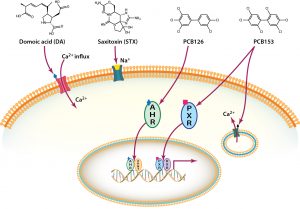Toxicant Induced Alterations in DNA Methylation

The objective of this project is to investigate the role of DNMT3s in the long-term effects of developmental exposure to toxicants. Recent studies have implicated epigenetic mechanisms such as DNA methylation in the persistent effects of developmental exposure to toxicants. But, the mechanism by which DNA methylation patterns are altered is not known. Using zebrafish as a model system, we are investigating the role of DNMT3 genes in toxicant-induced alterations in DNA methylation patterns. In contrast to mammals (DNMT3A and DNMT3B), zebrafish possess multiple DNMT3s, due to a genome duplication event in the fish lineage shortly after their divergence from tetrapods. They are all the homologs of mammalian DNMTs. Genome duplication often leads to subfunction partitioning among the duplicated genes. This provides an unique opportunity for obtaining new mechanistic insights into the multiple functions of a single human gene. Using individual DNMT3 knockout animals, we are studying the role of DNMT3s in toxicant-induced alterations in DNA methylation.
Oceans and Human Health

The overall objective of the proposed research is to elucidate the cellular and molecular mechanisms by which early-life exposure to harmful algal bloom (HAB) toxins may interfere with neurodevelopment to cause persistent neurobehavioral changes later in life. The HAB toxins domoic acid and saxitoxin occur in seafood and levels are regulated to prevent acute toxicity. However, human exposure to these toxins at levels below regulatory limits is common, widespread, and may be increasing, posing risks to vulnerable subpopulations such as developing humans. It is now well known that the early life environment can profoundly influence health throughout the life course (the developmental origins of health and disease). However, the mechanisms by which developmental exposures elicit effects later in life are not well understood. We are working on the hypothesis that early life, low-level exposure to domoic acid and saxitoxin targets neurotransmitter receptors and ion channels, leading to altered gene expression, functional changes in glial and neural cells, and long-term changes in neurobehavioral function in adults. This project is part of the Woods Hole Center for Oceans and Human Health (WHCOOH).
Effect of toxicants on the epitranscriptome
Hypoxia-induced epigenetic changes in a marine fish
The objective of this study is to characterize the epigenetic effects of exposure to hypoxia in a marine fish species (Fundulus heteroclites). Hypoxia (reduced oxygen levels) is one of the major environmental stressors in coastal marine environments, which is expanding globally. Coastal ecosystems serve as an important habitat for embryonic and larval stages of a variety of vertebrate and invertebrate species. Most of the studies aimed to understand how coastal organisms cope with hypoxia and other environmental stressors during critical periods of early development can have long-term consequences, seen only at later stages of life. These long-term effects of exposure are mediated by epigenetic regulation of gene expression. We will employ the latest technologies to quantify genome-wide epigenetic changes. Furthermore, we will determine the relationship between epigenetic changes and gene expression patterns. The results from this study will determine the mechanistic basis for the long-term effects of exposure to hypoxia during sensitive stages of early development.
Collaborations
Impact of Ocean Acidification on Arctic invertebrates (Collaboration with Dr. Howard Browman at Institute of Marine Research in Norway)
The objective of this study is to study the effects of OA on marine cladocerans. The effects of temporal and spatial variations in multiple OA drivers (e.g. pCO2, salinity and temperature) on the physiology, transcriptomic and epigenetic changes will be investigated. Marine cladocerans (Podon spp. and/or Evadne spp.) will be used as a model to investigate the relative roles of genetic and epigenetic mechanisms in determining the adaptation capacity of marine populations to CO2 and temperature. Cladocerans are widely used as models to study the evolutionary basis of phenotypic plasticity because they reproduce clonally (asexually) and sexually, which offers a unique opportunity to assess the relative contributions of the epigenetic (in clonal populations) and genetic (in sexually reproducing populations) mechanisms underlying adaption to environmental drivers, and their molecular basis.
